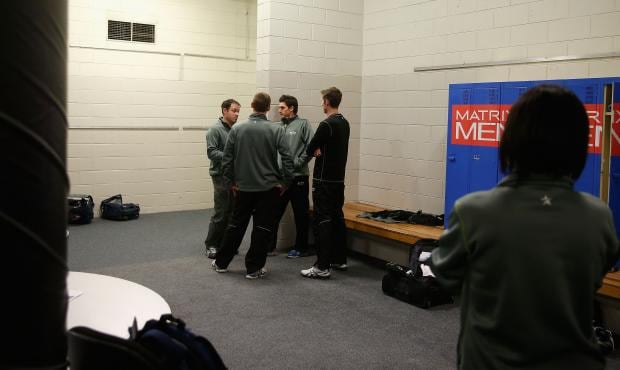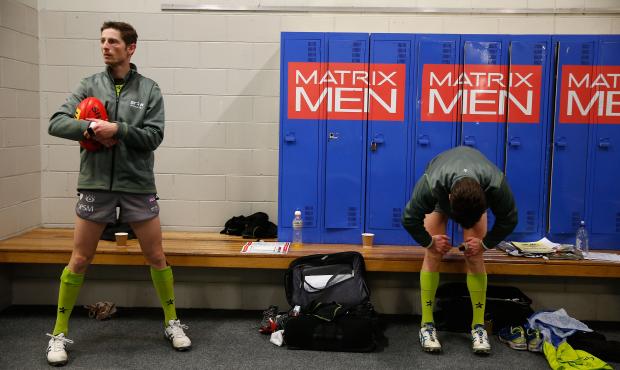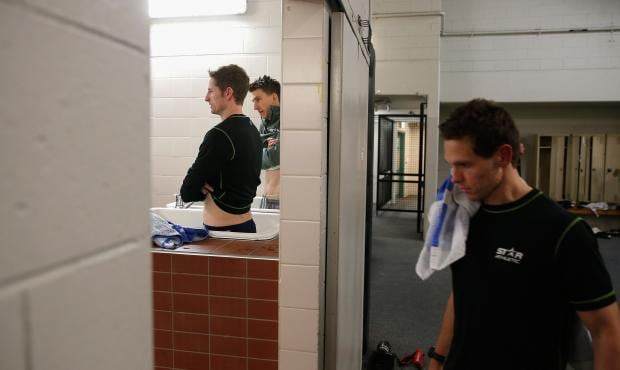FOOTBALL is a winter sport. There's no getting away from that when Matt Stevic, Sam Hay and Jason Armstrong arrive at the wild and woolly MCG two hours before the round 17 Melbourne-Geelong match.
Almost as soon as they change into their warm-up gear, they head out into the middle of the MCG to practice their centre bouncing.
What's unique about football when compared to any other sport is that its umpires don't just adjudicate the game, but are required to execute a precise skill as well.
The centre bounce is an iconic feature and as they begin their match-day preparation, the umpires are keen to establish whether conditions in the centre of the MCG will allow that. Rain has fallen throughout the morning with plenty more forecast.
"It's a bit sloppy out there," says Armstrong as he returns to the rooms. "I'm not sure if the rain comes that the centre will hold."
And while no umpire is unhappy with a Saturday afternoon assignment at the MCG at the near-traditional time of 1.45pm, they do note ruefully that days like today – when the temperature will not pass 10 degrees Celsius – are the reason Etihad Stadium was built with a roof.
The umpires have studied the teams all week and once the gritty weather is factored in, their belief that they are in for a tough afternoon is only strengthened. Melbourne will try to lock things down; Geelong will try to get the game played on the outside.
Michael Vozzo is the dedicated umpires' coach for the day and he talks quietly to the umpires about 75 minutes before the match. Key themes are repeated – watch the tall marking forwards and keep an eye on the taggers. "Be positive, be on your toes and cover your area," he tells them.
"It's wet-weather footy but nothing really changes for us. Number one, it is about protecting the guy with the footy and the guy at bottom of the pack because the ball will spend more time on the ground," he says.
Umpires coach Michael Vozzo gives the boys some final instructions
Vozzo leaves the room with 40 minutes to go before the start of the match and heads to the observation room in the Ponsford Stand to await the start of the game. "I like to get out of their hair," he says.
The umpires' rooms are beneath the Great Southern Stand. Previously used by clubs before of an upgrade of the northern side of the ground, they are quite spacious. The space is a buzz of activity with the boundary and goal umpires also preparing, but there is enough room for anyone seeking to be on their own, to contemplate the afternoon ahead.
Goal umpire Mark Canning is the unofficial timekeeper and every 10 minutes on the dot, lets the rest of the crew know how long it is until they need to be on the ground.
With just an hour before the game, Stevic, Armstrong and Hay leave for the Melbourne and Geelong rooms for a quick meet and greet. It is nothing more than an opportunity to shake hands and answer some last-minute questions. But when they return they are drenched (having walked the boundary to get to the northern side rooms); the weather looks really threatening and Stevic suggests the umpires wear their thick warm-up jackets when they go on to the ground. "We don't want to freeze," he says with a laugh.
Apart from the weather, there is another lively talking point for the umpires. The night before in Adelaide, Ray Chamberlain blew his whistle before the siren sounded at the end of the third quarter of the Crows-Hawthorn clash and much of the pre-match chatter is devoted to that. Armstrong tells the others that when he was in Adelaide a fortnight ago for the Crows-Power Showdown he couldn't hear the end-of-quarter chime in his earpiece.
A few years back, Chamberlain’s effort might have been the butt of jokes when the umpires gathered for Monday night training, but these are different times. "We have this great, supportive culture," explains Stevic. "We have fun but we've gone away from the culture of taking the piss out of things we might have got wrong on the weekend. Now it's all about constructive feedback."
Twenty minutes before the game, the mood turns more serious. The umpires are fitted with their vests that carry the communication devices they need, including their earpiece. Canning's countdown is now every two minutes. And just like in every football dressing room in Australia, the valuables bag is passed around and placed in the care of a steward until after the match.
Umpires go through their final stretches before taking to the field
But there is no rah-rah in the final few moments before they head to work. Instead, there are lots of firm handshakes and a quiet "Let's go boys" as they walk up the ramp and disappear out of sight.
All the umpiring heavies are in the viewing room, which sits alongside the Grey-Smith bar in the MCC Members' Stand above the half-forward flank. It's a brisk five-minute walk from the rooms. AFL national umpiring director Wayne Campbell and AFL umpires' coach Hayden Kennedy are also at the game, as are the observers looking after the boundary and goal umpires. Injured field umpire Chris Kamolins is also watching from up high, keen to bounce ideas off the coaches.
But Vozzo is the man in charge and he watches the game unfold in front of him with a laptop into which he can input statistics and notes. He's wearing an earpiece that allows him to listen to every communication between the three field umpires.
The communication devices have been a godsend. Prior to their adoption, the umpires used a series of hand gestures to take control of play. Now a simple "mine" or "yours" is enough. The technology has also become a great coaching device and those watching on television have come to appreciate the added layer of information they bring to a broadcast.
"I think they've created a greater insight to what we do," Armstrong says. "As long as we keep the communication short, succinct and accurate, I see no problem with it. The benefits outweigh the negatives."
Watching the game entirely through the prism of the umpires is a fascinating exercise. The ebbs and flows of the game don't matter and player statistics simply are not important. Even the score becomes irrelevant after a time. Geelong is expected to dominate and win easily, but when your focus is solely on the three controlling umpires, you barely notice what the players are doing.
The umpires start the game by bouncing the ball and it is communicated to the players before the first bounce that the ground is firm enough to keep doing that. What they also do is wait for a signal from the broadcaster before restarting play after a goal is scored and they also very firmly, before every bounce and ball-up, indicate to the players which direction they will head after play is restarted. The communication is clear and succinct and leaves the players in no doubt as to the umpires' intended movement.
Upstairs, the coaches watch the play quietly and listen to the audio feed with intent. Occasionally, the merits of a decision are debated, or the positioning of umpires critiqued.
To this observer, it appears an uneventful match. The conditions made it hard, particularly after a half-time downpour, but there is a period of free-flowing play as Melbourne tries to open things up in an attempt to get back into the contest.
From their perch high above the ground, the coaches like what they see. An early block paid to Melbourne earns the umpires a big tick. The coaches also are generally satisfied with the umpires' decision-making, communication and positioning.
Listening to the umpires, it is clear Stevic is their unofficial leader. He leads the way with encouragement and instructions to the players, particularly the ruckmen. He also has the confidence to banter with them that bit more, at one stage asking Steve Johnson whether he would have had a shot when the Geelong star tried to claim a free kick on a tight angle that was paid instead to a teammate.
Another time, he pays a tripping free kick to Cat Cam Guthrie and theatrically replays the incident to an inquiring Melbourne player by way of explanation.
During the second quarter, Stevic tells his partners to keep an eye on Geelong's Allen Christensen and Melbourne's Neville Jetta as tempers become frayed. Sure enough, the pair wrestles again. Armstrong spots it immediately and pays a free kick to Jetta directly in front of goal. The coaches roar their approval immediately, delighted the communication between the umpires ensured a deserving free kick was paid.
Vozzo and Kennedy talk to the umpires briefly at half-time, but only to outline one or two key points. There are minor issues to be addressed but they can wait until the debrief the following week, and by the start of the final quarter, Kennedy and Campbell have left the ground, having seen enough to know it was a well-umpired game. Stevic continues his good form all day, while Hay and Armstrong enhance their claims as they both seek to take charge of a final for the first time.
Not that all fans are satisfied. As the umpires walk off the ground after the final siren with the rain finally tumbling heavily down, one Geelong supporter is there to give them plenty of lip as they approach the tunnel. Apparently a 66-point Cats win is not enough to satisfy this enraged supporter. "Look at the scoreboard!" he howls at them.
The field umpires are used to this and ignore what he says. One of the boundary umpires, though, looks at the supporter and can't suppress a giggle.
"It was a tough day at the office," says Armstrong as he simultaneously peels off his uniform and munches on a slice of pizza from the buffet of hot food, fruit, lollies and soft drinks that await the umpires straight after the game. "Lots of players around the ball, lots of 50-50 decisions to make."
Adds Stevic: "There were a lot of contested possessions, a lot tackles, (167 according to the official match statistics) and plenty of high tackles. There was much to process and a bit to manage, but the good thing, considering the weather, was that there were no sliding tackles."
All three agree one-sided games are harder to umpire because of the challenge to stay focused. It is easier to stay alert, they say, when games are tight and every possession and every decision counts.
The umpires head to the showers as soon as they can, where both hot and ice baths await them, talking about what they observed during the game and what they'd like to raise with the coaches. They didn't wear GPS monitors in this game, but Hay says the last time he did, he was charted at having run about 12km, which he says is about standard for a game.
Umpires stand in ice baths as part of their recovery.
The three umpires expect to be graded for their efforts. Armstrong, having recorded the match at home, will conduct his own review later that night, even before receiving his feedback from Vozzo. But there is a reason for his haste. Every umpire does the occasional double shift weekend, when they officiate one day and sit as the emergency the next. He will back up at the MCG the same time the next day for the Essendon-Collingwood match, with his fingers crossed that he won't be needed.
The umpires' last task for the day is one of their most important. Once the room is cleared, Stevic, Hay and Armstrong will sit and decide the Brownlow Medal votes. Sometimes it can be clear-cut, while at other times the discussions can take up to 20 minutes. Emergency umpire Heath Ryan will be there to provide input as someone who watched the game from the other side of the boundary, but the final say goes to the three men in charge.
The grading for their umpiring will be known within days and will be a tightly held secret. But if they are seen to have stuffed up the Brownlow votes, they'll hear about it for years.
POSTSCRIPT
The big takeaway from having an access all areas pass to AFL umpires for the week is not witnessing their dedication to their craft, their fitness or their passion for what they do. They are elite athletes - good at their craft and driven to get better. All the signs from the AFL are that they will be given every opportunity to continue getting better.
But there is nothing perfunctory about the umpires. The throwaway line from so many footy fans is that they have no feel for the game because of the way they umpire. I have always suspected that's not right, but after a week of sitting in their meetings, watching them train and observing their games, I'm now certain that's not the case.
These umpires get footy. They understand it, at least all the parts that really matter and are as driven as all key AFL stakeholders are to make it the best game to play and to watch. They're not the reason we go to the footy, but they're still part of the family and from now on, I'll be embracing them as such.






